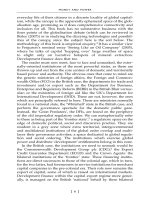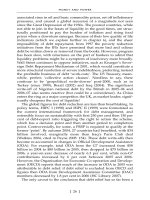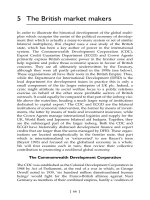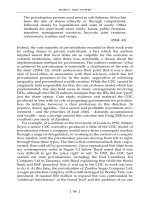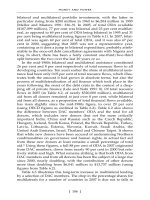customer cultur how fedex and other great companies put the customer first everyday
Bạn đang xem bản rút gọn của tài liệu. Xem và tải ngay bản đầy đủ của tài liệu tại đây (3 MB, 301 trang )
An Imprint of PEARSON EDUCATION
Upper Saddle River, NJ • New York • London • San Francisco • Toronto
Sydney • Tokyo • Singapore • Hong Kong • Cape Town
Madrid • Paris • Milan • Munich • Amsterdam
www.ft-ph.com
Customer Culture:
How FedEx
®
and Other Great
Companies Put the
Customer First Every Day
Michael D. Basch
02FMTitle.FM Page v Friday, May 10, 2002 12:05 PM
Library of Congress Cataloging-in-Publication Data
Basch, Michael.
Customer culture : how Fed Ex and other great companies put the customer first
every day / Michael Basch.
p. cm. (Financial Times Prentice Hall)
Includes index.
ISBN 0-13-035331-0
1. Corporate culture. 2. Organizational effectiveness. 3. Quality of work life. 4.
Customer loyalty. 5. Corporate culture Case studies. 6. Organizational effective-
ness Case studies. I. Title. II. Financial Times Prentice Hall books
HD58.7.B372 2002
658 dc21
200202068
Editorial/production supervision:
Laura Burgess
Executive editor:
Tim Moore
Editorial assistant:
Allyson Kloss
Marketing Manager:
Bryan Gambrel
Manufacturing buyer:
Maura Zaldivar
Cover design director:
Jerry Votta
Cover design:
Anthony Gemmellaro
Art Director:
Gail Cocker-Bogusz
© 2002 by Prentice Hall PTR
A division of Pearson Education, Inc.
Upper Saddle River, New Jersey 07458
Prentice Hall books are widely used by corporations and government agencies for
training, marketing, and resale.
For information regarding corporate and government bulk discounts please contact:
Corporate and Government Sales
Phone: 800-382-3419 or
All product names mentioned herein are the trademarks or registered trademarks of
their respective owners.
All rights reserved. No part of this book may be reproduced, in any form or by any
means, without permission in writing from the publisher.
Printed in the United States of America
10 9 8 7 6 5 4 3 2 1
ISBN 0-13-035331-0
Pearson Education LTD.
Pearson Education Australia PTY, Limited
Pearson Education Singapore, Pte. Ltd.
Pearson Education North Asia Ltd.
Pearson Education Canada, Ltd.
Pearson Educación de Mexico, S.A. de C.V.
Pearson Education—Japan
Pearson Education Malaysia, Pte. Ltd
.
02FMTitle.FM Page vi Friday, May 10, 2002 12:05 PM
Praise for CustomerCulture
“
Mike Basch was a key member of the early FedEx team that
instilled the extreme dedication to customer service that revolution-
ized the transportation industry.”
Frederick W. Smith
Founder and CEO, FedEx, Memphis, TN
“
Creating raving fan customers is the only way to go. Michael
Basch, in his book,
CustomerCulture,
will teach you how to do that
every day!”
Ken Blanchard
coauthor, “The One Minute Manager
®
” and “Whale Done!
™
”
“
Basch has captured in
CustomerCulture
the causal factors as to
why certain organizations excel in customer loyalty while others con-
tinually struggle to keep their customer first.”
Jim Barksdale
former CEO of Netscape and
current partner of The Barksdale Group, Menlo Park, CA
“CustomerCulture
clearly and succinctly points the way to the
magical land of customer service excellence with enlightening insights
into applications for businesses large and small. Buy it, read it, do it;
make your world a better place.”
Roger Frock
former General Manager, FedEx, Memphis, TN
“
Mike Basch knows so many ways to get your organization closely
bonded with your customers, members, or clients that it would be a
business shame for you not to read this book at least three times and
then make it mandatory reading by every manager, supervisor, staff
member, and new hire. I’ve learned more about creating world class
business culture and owning the relationship with your customers
from Mike Basch than I have from any other expert on the subject.
Pray you read this book before your competition does.”
Jay Abraham
Author of “Getting Everything You Can Out of All You’ve Got”
“
There’s more wisdom in this book than you would gain as a gradu-
ate from a Top 5 business school! There’s nothing like having ‘been
there and done that’ and Mike Basch has done both! That’s what you
will learn from this reading this book, authored by a true ‘Captain of
Industry.’ Mike is both the message and the messenger when it comes
to connecting your customers and your ‘Corporate Culture.’ The end
results? A healthier bottom line! You’re in the people business! It’s the
customer, Stupid!”
Francis X. Maguire
President/CEO, Hearth Communications, Los Angeles, CA
01FMEndors.fm Page i Friday, May 10, 2002 11:31 AM
“I had the good fortune to work with Mike Basch for a number of
years. His understanding of the importance of organizational cul-
ture and his ability to build or transform cultures delivers ever-
increasing value to customers, employees, and owners. If you want
to take your culture to the next level, implement the principles in
CustomerCulture.”
Dennis Jones
COO, Commerce One, Pleasanton, CA
“Mike Basch’s work with Larson-Juhl’s managers helped us to
understand the relationship between our actions, the company cul-
ture, and its impact on the people who actually build (or destroy) cus-
tomer loyalty—our frontline team members. His
CustomerCulture
thinking got us to implement real goals, measurements, and rewards—
all of which led to passionate employees delivering extraordinary ser-
vice. I grew as a leader in the process.”
Bill Trimarco
Senior Vice President, Larson-Juhl, Norcross, GA
“An organization of people is a living, breathing organism. Its soul
is the cultural structures that give the organization its character, its
purpose, and thus, its value to its customers. Mike Basch’s
Customer-
Culture
shows us as leaders in business how to proactively build those
structures that breathe life into our organization. It’s a great book!”
Thomas Oliver
Chairman & CEO, Six Continents Hotels, PLC, London, England
“You have in your hands a phenomenal ‘toolkit’ for unlocking the
full potential of your organization. Mike Basch has been in the
trenches and knows how to make these tools work in the real world.
His techniques are incredibly simple and incredibly powerful. I use
them daily, both with my clients, in my own company, and now in a
university program I teach for executives who are leading organiza-
tional change. This book is the core of that program because it’s about
putting theory into action for enduring results.”
Ravi Tangri
CEO, Chrysalis Performance Strategies Inc., Halifax, N.S., Canada
“Now the other 95% of companies have access to the roadmap
responsible for making the top 5% of companies so great. It begins
with a positive culture.”
Scott de Moulin
President/Founder, Destiny Training Systems, Los Angeles, CA
01FMEndors.fm Page ii Friday, May 10, 2002 11:31 AM
In an increasingly competitive world, it is quality
of thinking that gives an edge. An idea that opens new
doors, a technique that solves a problem, or an insight
that simply helps make sense of it all.
We must work with leading authors in the fields of
management and finance to bring cutting-edge thinking
and best learning practice to a global market.
Under a range of leading imprints, including
Financial Times Prentice Hall,
we create world-class
print publications and electronic products giving readers
knowledge and understanding which can then be
applied, whether studying or at work.
To find out more about our business and professional
products, you can visit us at www.phptr.com
F
INANCIAL
T
IMES
P
RENTICE
H
ALL
B
OOKS
For more information, please go to www.ft-ph.com
Dr. Judith M. Bardwick, PhD
Seeking the Calm in the Storm: Managing Chaos in Your Business Life
Thomas L. Barton, William G. Shenkir, and Paul L. Walker
Making Enterprise Risk Management Pay Off:
How Leading Companies Implement Risk Management
Michael Basch
CustomerCulture: How FedEx and Other Great Companies Put the
Customer First Every Day
Deirdre Breakenridge
Cyberbranding: Brand Building in the Digital Economy
William C. Byham, Audrey B. Smith, and Matthew J. Paese
Grow Your Own Leaders: How to Identify, Develop, and Retain
Leadership Talent
Jonathan Cagan and Craig M. Vogel
Creating Breakthrough Products: Innovation from Product Planning
to Program Approval
Subir Chowdhury
The Talent Era: Achieving a High Return on Talent
Sherry Cooper
Ride the Wave: Taking Control in a Turbulent Financial Age
James W. Cortada
21st Century Business: Managing and Working
in the New Digital Economy
James W. Cortada
Making the Information Society: Experience, Consequences,
and Possibilities
Aswath Damodaran
The Dark Side of Valuation: Valuing Old Tech, New Tech,
and New Economy Companies
Henry A. Davis and William W. Sihler
Financial Turnarounds: Preserving Enterprise Value
Sarv Devaraj and Rajiv Kohli
The IT Payoff: Measuring the Business Value
of Information Technology Investments
FinancialTimes_series.fm Page 1 Thursday, April 18, 2002 2:18 PM
Jaime Ellertson and Charles W. Ogilvie
Frontiers of Financial Services: Turning Customer Interactions
Into Profits
Nicholas D. Evans
Business Agility: Strategies for Gaining Competitive Advantage
through Mobile Business Solutions
Kenneth R. Ferris and Barbara S. Pécherot Petitt
Valuation: Avoiding the Winner’s Curse
David Gladstone and Laura Gladstone
Venture Capital Handbook: An Entrepreneur’s Guide
to Raising Venture Capital, Revised and Updated
David R. Henderson
The Joy of Freedom: An Economist’s Odyssey
Philip Jenks and Stephen Eckett, Editors
The Global-Investor Book of Investing Rules: Invaluable Advice
from 150 Master Investors
Thomas Kern, Mary Cecelia Lacity, and Leslie P. Willcocks
Netsourcing: Renting Business Applications and Services
Over a Network
Al Lieberman, with Patricia Esgate
The Entertainment Marketing Revolution: Bringing the Moguls, the
Media, and the Magic to the World
Frederick C. Militello, Jr., and Michael D. Schwalberg
Leverage Competencies: What Financial Executives Need to Lead
D. Quinn Mills
Buy, Lie, and Sell High: How Investors Lost Out on Enron and the
Internet Bubble
Dale Neef
E-procurement: From Strategy to Implementation
John R. Nofsinger
Investment Blunders (of the Rich and Famous)…And What You Can
Learn From Them
John R. Nofsinger
Investment Madness: How Psychology Affects Your Investing…
And What to Do About It
FinancialTimes_series.fm Page 2 Thursday, April 18, 2002 2:18 PM
Tom Osenton
Customer Share Marketing: How the World’s Great Marketers Unlock
Profits from Customer Loyalty
W. Alan Randolph and Barry Z. Posner
Checkered Flag Projects: 10 Rules for Creating and Managing Projects
that Win, Second Edition
Stephen P. Robbins
The Truth About Managing People…And Nothing but the Truth
Eric G. Stephan and Wayne R. Pace
Powerful Leadership: How to Unleash the Potential in Others
and Simplify Your Own Life
Jonathan Wight
Saving Adam Smith: A Tale of Wealth, Transformation, and Virtue
Yoram J. Wind and Vijay Mahajan, with Robert Gunther
Convergence Marketing: Strategies for Reaching
the New Hybrid Consumer
FinancialTimes_series.fm Page 3 Thursday, April 18, 2002 2:18 PM
Fm01.qxd 3/30/01 10:19 AM Page vi
This book is dedicated to
my wife and partner, Karen, and to
my three children Lisa, Jeff, and Michael
04Dedication.fm Page xi Tuesday, April 30, 2002 3:37 PM
04Dedication.fm Page xii Tuesday, April 30, 2002 3:37 PM
xiii
Contents
Foreword xvii
Introduction xxi
P
ART
1
The Theory 1
C
HAPTER
1
America, You Have a New Airline
and…a New Standard of Service 3
C
HAPTER
2
Systems Drive People 21
A UPS Systems Example: Reducing
Transaction Costs… 28
Background 28
Problem 29
Systemic Cause 30
Solution 30
Result 31
Postscript 31
Another UPS Example: An Elegant Solution
to Reduce Mis-sorts 32
Background 32
Problem 33
Systemic Cause 33
Solution 34
Result 36
Postscript 36
A Federal Express Example: On-time
Departure 36
Background 36
05FMTOC.fm Page xiii Tuesday, April 30, 2002 3:37 PM
Contents
xiv
Problem 37
Systemic Cause 37
Results 38
Postscript 38
C
HAPTER
3
Vision 41
The First Need of People Is to Have Their
Physical Needs Met 43
Stage Two Is Meeting Informational Needs
45
Stage Three Is Meeting Emotional Needs 47
Stage Four Is Spiritual Needs 50
C
HAPTER
4
Values as Words Versus Values as
Actions 53
C
HAPTER
5
Goals 63
C
HAPTER
6
Relevance 73
You Get What You Recognize 83
Invention of the EAGLE Card 85
Legendary Stories Encourage Legendary
Behaviors 88
C
HAPTER
7
You Can’t Manage or Innovate What
You Can’t Measure 95
A Good Example Where Feedback Has Been
Lost Is the U.S. Healthcare System 103
C
HAPTER
8
Extraordinary Service Is Delivered
by its Creators 109
05FMTOC.fm Page xiv Tuesday, April 30, 2002 3:37 PM
Contents
xv
P
ART
2
The Application 121
C
HAPTER
9
The Phoenix Dog Piss Theory 123
C
HAPTER
10
Big Companies Are Like Big Ships—
Slow to Move and Slow to ChangE
131
C
HAPTER
11
Systemize the Routine; Humanize
the Exception 141
You Can Turn Angry Customers into Raving
Fans Simply by Solving Their Problems
142
C
HAPTER
12
The Single Egg Organization 151
The Single Egg Organization 154
Federal Express Creates FedEx Services
156
Larson-Juhl Combines Sales and Service
Locally 158
Bell Sports Sets Up Separate Companies
159
C
HAPTER
13
The Hierarchy of Horrors 161
C
HAPTER
14
The Seven Dynamics of Change 171
Dynamics of Change Exercise 172
How to Deal with the Dynamics of Change
176
The Two Ingredients to Innovative Success
181
05FMTOC.fm Page xv Tuesday, April 30, 2002 3:37 PM
Contents
xvi
What Is the Process and How Is It
Compatible with Systems Thinking? 182
Reducing the Workforce 184
The Hudson River Runway 185
P
ART
3
The Results 189
C
HAPTER
15
The Paddi Lund Story 191
The Courtesy System 206
C
HAPTER
16
Anatomy of a Start-Up: Innovation
in Action 209
C
HAPTER
17
Anatomy of a Turnaround: Customer
Culture in Transition 223
A
PPENDIX
A
The Vision of the Ideal at a Federal
Express Station 241
The Federal Express Station: An Ideal 243
The Ideal Station 243
Postscript 249
A
PPENDIX
B
The UPS Philosophy As Stated by
Its Founder 251
Quotes 254
Determined Men 258
Index 267
05FMTOC.fm Page xvi Tuesday, April 30, 2002 3:37 PM
xvii
Foreword
Mike Basch’s part in the history of corporate America is
extraordinary.
He has been involved in big, exciting corporate businesses like
UPS and Federal Express that deal annually with customers in
the millions. Looking back, Mike’s role and principle responsi-
bility in these legendary businesses has been to create a strong
CustomerCulture, although it was not called that at the time,
which has been integral to the long-term success and domi-
nance of these companies in their respective industries.
Systems engineering, sales, customer service, corporate mis-
sion statements…they are all part of the mix of any modern day
business, but only Mike sees clearly the relationship between
these issues, a true CustomerCulture and the incredible com-
pany success of which corporate legends are made.
From One Extreme to Another
In contrast, I have a humble enterprise in a working-class sub-
urb in Australia. It’s flattering that Mike would ask me to write
this forward and would feature my business as a prominent
06FMForew.fm Page xvii Friday, May 10, 2002 11:33 AM
Foreword
xviii
example of his principles in action. Perhaps I should briefly
explain why.
Much has been said about me and my little dental business
over the years, Mike being the keenest proponent. My business
is successful and makes me more money than I can easily
spend. I work three short days a week, and I love every minute
I’m at the office—which is unusual given my profession.
My business is very
small by most standards. Long ago I
locked my front door and fired most of my customers, which
is probably why I’m considered a little “crazy.” I now have
around 750 clients, in contrast to Mike’s millions. Over time
we have learned to treat our customers very well. Indeed, that
is the sole reason we generate income so efficiently.
The Process of Customer Success
I first met Mike when he visited my business a few years ago.
He impressed me with his honesty and friendliness, as well as
his depth of knowledge about business in general and cus-
tomer service in particular.
Most people are intrigued with the sensational side of my
story, but Mike better than anyone else has looked past that
to study my business deeply. He identified clearly the process
that led us to create the experience my customers now enjoy
that brings them back time and again, and attracts their
friends, family, and colleagues.
It is telling about Mike’s insight and skills that he has managed
to distill the essence of not just the customer-service ideas of
my small business, but those of medium- and large-sized busi-
ness as well. And I think you’ll find his process for building
that into a pervasive CustomerCulture to be quite exciting.
06FMForew.fm Page xviii Friday, May 10, 2002 11:33 AM
Foreword
xix
Customer Service by Chance
Unfortunately, I can’t quite claim that I deliberately set out to
create exactly what we achieved. My motivations were far sim-
pler—I simply wanted customers to give me money more eas-
ily. Customer Service. That must be the answer, otherwise
why would people want to come see a dentist. Perhaps you’ve
experienced the same rationale?
Like most people, I must admit to doing only what seemed
obvious at the time. I didn’t have a process to follow, or a plan
to reveal the path before me. But somewhere along the way,
and after many years and many blind alleys, our customer ser-
vice focus became a strong CustomerCulture. It’s now instilled
in all of our people and all that we do. I only wish I’d met
Mike sooner!
Customer Culture by Design
In hindsight, I can see now that the central principles of great
customer service are simple: Work out what it takes to make
customers happy, implement systems to provide this happi-
ness, show the team how it is to their advantage to follow the
system, and continually measure and track your team’s perfor-
mance as you evolve to higher and higher levels of customer
loyalty.
As you’ll see in a little while, Mike identifies the steps in this
process as
Vision
,
Values
,
Goals
,
Relevance
,
Action,
and
Feed-
back
. It seems so simple now! Unfortunately, the devil is in
the detail, but Mike will hold your hand along the way,
drawing on his vast experience with a broad range of ideas
and theories.
06FMForew.fm Page xix Friday, May 10, 2002 11:33 AM
Foreword
xx
My favorite is “The Phoenix Dog-Piss Theory” in Chapter 9. I
must confess to being thoroughly delighted with this manage-
ment gem. So much so that I decided to propound my own
“Two Kangaroos Loose on the Barbie Hypothesis,” which I
think would be a great addition to Mike’s next book.
Theories aside, deep down we all know how customers want
to be treated…because we are all customers ourselves. We have
all experienced the same problems that our own customers face,
and we have taken our custom away from places where we did
not feel welcomed.
You innately understand how creating a culture of treating
customers exceptionally well can be a very effective way to
grow businesses, create new markets, and dominate industries.
Within the pages of this book lie the answers to many of the
problems you’ll face in doing just that.
Mike is a warm, caring human being, but also a savvy manage-
ment mastermind with an eye for sifting the valuable dia-
monds from the otherwise functional bits of coal. Join him as
he recounts his journey through corporate American history.
What you’re about to learn could very well change your
approach to work, and certainly has the capacity to transform
your organization.
Dr. Paddi Lund, BDS, FRACDS
Patrick Lund’s Dental Happiness
06FMForew.fm Page xx Friday, May 10, 2002 11:33 AM
xxi
Introduction
C
ulture drives performance in an organization. Culture is
everything. As one Chief Executive Officer (CEO) recently put it:
“Get the culture right, and your people will do what is necessary
to serve their customers and make owners piles of money.” Put
an average human being in an above-average culture, and the
person will change behaviors to adapt to the new culture.
Change the culture in an existing company, and the people will
change with it.
An organizational culture is a system. That system can drive
people to high performance directed toward profitable customer
loyalty, or it can drive apathy, internally directed, or any number
of destructive “customer cancerous” activities.
We are creatures of habit. Action and reaction are programmed
early in life, and we respond the way that we have always
responded, unless there is a change in the action/reaction struc-
tures, which are those structures that give us the opportunity to
experience pleasure or to avoid pain.
Nearly all that we do is conditioned by habit, and habit is the
result of culture. Build a culture where the behaviors you desire
are clear and recognized, and people will gradually build habits
around those behaviors. Then, the organization will habitually
serve its customers with ever-increasing value.
07FMIntro.fm Page xxi Friday, May 10, 2002 11:34 AM
Introduction
xxii
People change, not because managers direct them to change, but
because they find themselves in a culture where personal change
is in their best interest.
Assuming you, as a corporate or group leader or even as an
employee, want to become part of changing the way that people
behave in some way, you must change the culture that these
people operate in. In effect, you must change the system or the
action/reaction paradigm that makes up your corporate (or fam-
ily) culture.
People instinctively adapt to the culture they step into. If the
culture is high performing, people will be high performing or will
leave if they are not willing to perform to the cultural standards.
CustomerCulture is about consciously building the customer-
centered organization where employees are focused on serving
their customers (internal or external) for sustained, profitable
growth.
Back to systems that drive our behaviors. Some simple examples
of systems in action…
You step into a shower and turn the water on. With one hand in
the water and the other on the valve, you gradually move the
valve until the water is the right temperature. You sense the
water temperature, unconsciously compare it to the temperature
you desire, adjust the valve to change it if it’s not right, and con-
tinue to go through this cycle until the temperature is right.
Over time, innovative people and manufacturers develop valves
where, as a customer, you set the right temperature on the front
end and simply turn the water on.
This is a simple example of how systems work and how customer
focus evolves products and solutions to customers’ needs.
Another example…
07FMIntro.fm Page xxii Friday, May 10, 2002 11:34 AM
Introduction
xxiii
You’re late for an important appointment. You get in your car
and quickly accelerate up to the speed limit. You constantly look
at the speedometer and press and release the gas pedal to reach
the optimum speed. You observe the traffic and what is going on
around you and take the necessary actions to minimize your
time on the road and to meet your goal of getting to your
appointment on time.
Over time, innovative people and manufacturers developed
cruise control, and now you simply get your car up to speed and
press the button to maintain the ideal speed. Your mind and
behaviors can then concentrate on other issues, increasing your
performance.
These are two simple examples of systems in action.
You have a
goal,
whether it is the right temperature or the right
speed. The goal is
relevant
to you at the moment. You take
action
to meet the goal, and you get
feedback
. If the goal is not
being met, the cycle continues with another action and feedback
until you have reached equilibrium (satisfaction) in the process.
On a macro scale, this becomes an evolutionary process. You go
through the
goal, relevance, action, feedback
cycle again and
again in nearly everything you do. As you go through this cycle,
you get inventive looking for solutions to make it simpler, easier,
faster, less expensive, more comfortable, and so forth.
The people and companies that do this constantly are the evolu-
tionary forces that continue to grow and innovate in their never-
ending quest for finding better ways. This is the definition of
CustomerCulture.
The purpose of this book is to (a) consciously develop cultural
structures or systems to get your employees into this process
and (b) look for better, more cost effective, and more valuable
ways to serve your customers.
07FMIntro.fm Page xxiii Friday, May 10, 2002 11:34 AM
Introduction
xxiv
When you have every employee and every customer looking for
ways to improve your effectiveness as an organization, you grow
and thrive.
When these simple and natural cultural structures are given con-
scious direction in an organization, the organization performs at
much higher levels. People have a sense of purpose and learn to
work together to innovate and grow constantly.
A company or organization either grows or decays. There is no
steady state over time. Change and growth is a core human need
and phenomenon. It cannot be denied. It is possible, however, to
set up the success structures to relearn your business every day.
This book is about getting conscious about understanding cul-
tural structures and building and applying them in ways that
enable you and your people to relearn your business every day,
to help you constantly grow in delivering products and services
focused on customers, products, and services that customers are
willing to pay for and that make you lots of money.
CustomerCulture seeks to apply a systems foundation to your
cultural structures and then to provide examples of how systems
thinking built Federal Express, United Parcel Service (UPS), Lar-
son-Juhl, a very exciting dental practice, a company turnaround,
a start-up, and many other companies.
The principles discussed in this book go back nearly 100 years to
UPS and its vision. They were then applied at Federal Express
during its embryonic phase and currently are being applied by
companies exercising these principles both in revamping exist-
ing cultures and starting up new businesses.
Federal Express is the primary example because I participated in
the initial development of the culture from the ground up. The
company’s culture has withstood the test of time and continues
to flourish against enormous competition from one of the best
companies in their industry—UPS.
07FMIntro.fm Page xxiv Friday, May 10, 2002 11:34 AM



